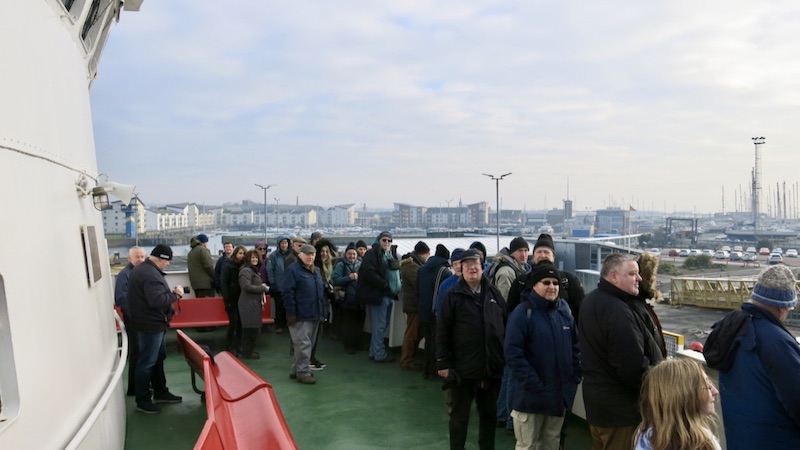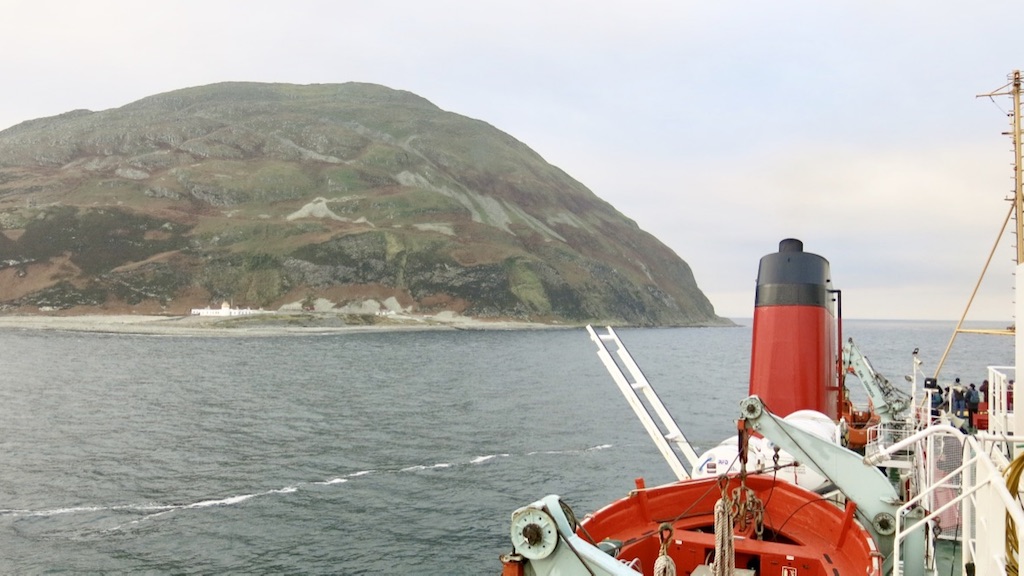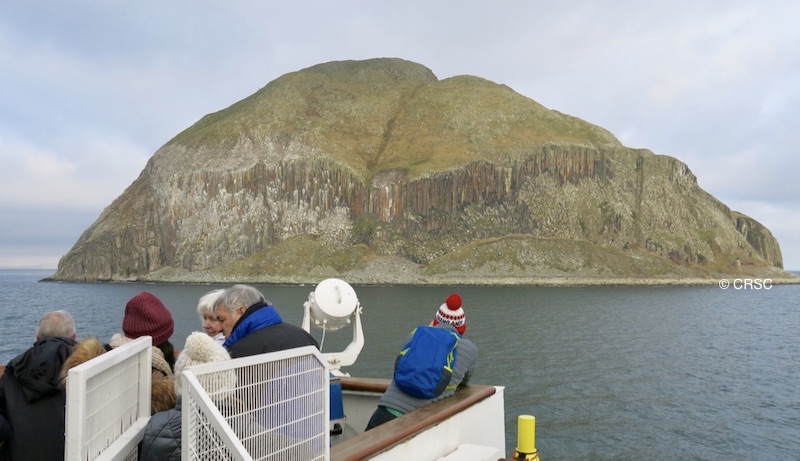
The closer the ship came, the greater the fever of anticipation: CRSC’s charter was the first time a modern CalMac ferry had given a public sailing round Ailsa Craig. MV Isle of Arran sailed clockwise and then anti-clockwise round the isolated granite island, and gave a spectacular demonstration of ‘turning on a sixpence’ off the lighthouse. We were really lucky with the weather: the waters were remarkably calm
Judging by its ambitious and imaginative Ailsa Craig charter of MV Isle of Arran, CRSC is aiming at a new level of engagement with CalMac. Robin Copland reports on a day that made him ‘feel positively giddy with excitement’.
For some of us, the technical problem that afflicted one of Isle of Arran’s lifeboats earlier this month, forcing the postponement of CRSC’s New Year cruise, was manna from heaven. Suddenly, the fault was fixed, a new date was set and the trip was back on — giving a second chance to those of us who, for one reason or another, would have had to miss the earlier date. And so, with a light heart and the weather gods smiling, the journey to Ardrossan on the morning of Saturday 19 January passed quickly.

Captain David Allen played a hugely influential role in the success of the latest CRSC charter of MV Isle of Arran. At Ailsa Craig he manoeuvred the ship in a way calculated to appeal to excursionists, giving us optimal views of the island. Within the acknowledged safety limits he also created a feeling of ‘open house’ on the bridge: he and his fellow officers explained the various aspects of navigation and answered all our questions with a smile. A native of Campbeltown, Captain Allen went to sea in his teens as a fisherman, in which role he quickly became familiar with the waters around Ailsa Craig. After working on North Sea ships he joined CalMac as a deck rating in 1991, began studying for his officer’s certificate in 1996 and became master of Lord of the Isles in 2009. For several years he was one of CalMac’s relief masters, working on all the big ships of the fleet. Which is his favourite? Without a moment’s hesitation he replies ‘This one’. He has known Isle of Arran as able seaman, 2nd Mate and Chief Officer, before being appointed master two years ago. ‘She’s just got something about her,’ he says. ‘She is a great sea ship, and we try to keep her as best we can.’ The crew numbers 26 (28 for the CRSC charter), and ‘with the variety of routes we cover, they get experience of all the ports.’ Towards the end of the cruise CRSC President Roy Paterson made an announcement on the ship’s loudspeaker system thanking Captain Allen and his crew for their superb efforts on our behalf
I love that long hill down into the port. You can see the harbour and, if you are lucky (I was too early this time round), you can see your ferry approaching. Though the sky was overcast, it was that kind of high thin cloud that you knew would eventually let the sun through. That said, Arran was lost in a distant mist. Who knew what the weather would do? Who cared? We were off for a day’s cruise in the company of fellow enthusiasts, so the weather could do its worst and we would still have a fine time of it.
Ardrossan harbour is going through a much-needed facelift. This is the gateway to Arran for goodness sake, and that fabled isle deserves better. In the seawall, you can see evidence of ambition. This is a sturdy structure fit for Mexico I dare say, but it has seen better days. Years of neglect give the place a forlorn look, but as soon as I joined the queue for tickets, all thoughts of decay were set aside and the chat started. You looked around and all you could see were weel-kent faces exchanging the latest news.
There were plenty of new faces too. Upwards of 240 souls had booked for this mid-winter cruise— 70 more than for last January’s Round Arran cruise, and last January was deemed a great success. Cruise co-ordinator Neil Guthrie, aided by Rob Beale, efficiently dispatched the multi-ticket package to each of the cruisers. Coffees were hastily drunk and at least one flat sausage roll consumed before there was a sudden lull in the waiting room. Someone — there’s always a first — had seen the upperworks of our ferry as she approached the harbour. There was a purposeful move towards the exit. Cameras were hastily removed from bags (just how many pictures were taken during the day?) and everyone rushed outside, anxious to take THAT picture. Round she came, business-like and efficient — and before we knew it, we were walking towards the bow door to board via the linkspan.
Isle of Arran was launched in December 1983 and entered service in April 1984. She was the first purpose-built ferry for the Arran run since the much-loved and lamented Glen Sannox in 1957. Her gross tonnage is 3,269 and she can carry 76 cars and 448 passengers. When built, she was future-proof — or so everyone thought. It wasn’t to be. Ten years later she was replaced as the main vessel on the route by Caledonian Isles — at 5,261 gross tons, a much larger vessel with capacity for 1,000 passengers and 110 cars. She now has to be helped at the height of the season, and for the past few seasons that help has come from Isle of Arran. Such is progress.
We cast off at 11.00 and headed south. ‘The auld trooper’ did well on the way down towards Ailsa Craig. Those with specialist maritime GPS units talked of speeds of 14½ knots, impressive for a 35-year old whose top speed was noted at the time she was built as 15 knots. Hardy souls stood on deck and reminisced about this and about that — but, to be fair, you did not need to be that hardy, as the weather was kind for mid-January.
Al Black, who lives in a house that abuts Cloch lighthouse, and to whose undoubted knowledge and expertise in these matters we therefore always defer, pointed out Pladda island off the south-east corner of Arran. No one thought to comment how odd said island looked at the time and the chat continued.
In the meantime, Pladda moved north — still looking a bit odd, I thought, but it was the moving thing that really surprised. I put it down to Einstein’s theory of relativity and basically shut up. Pladda continued to move north at a frightening pace for an island. Here I have to be fair to Al: he it was who first opined that the moving ‘island’ might, in fact, be a very oddly shaped submarine. The real Pladda was still where it should have been and had now appeared in all of its undoubted glory. The chat continued. Donald Stirling and Charles McCrossan spoke about curlers, photography and retired engineers who spent the first day of their retirement back at work. Jamie Shorthouse talked about tugs and Gavin Stewart spoke of auld troopers and engineering. The world, in other words, was put to rights.
A word about housekeeping. We were asked to choose a lunchtime sitting and there were three choices – twelve o’clock, one o’clock and two o’clock. Dilemma – which sitting? Twelve o’clock – a bit early; one o’clock – we’re at Ailsa Craig, so two o’clock it was. Choice made. We had also been asked to choose from the menu in advance (chicken curry and apple pie for me, if you must know), so that was a decision taken out of our hands on the day. All the stewards were truly magnificent. It is not easy to serve three sittings with 80 at each sitting in a dining room that literally holds 80 people, but they managed it and with a sense of humour and friendliness that was beyond the call of duty. They earned their pay this day – let that be recorded.

In addition to a voyage ticket (top), excursionists were each given a souvenir ticket to keep (below) and food-and-drinks tickets to hand in at the Mariners Restaurant for one of the three meal sittings
But, I’m ahead of myself. I was still out on deck watching Pladda when I felt it was time to explore our ship. In the main entrance lobby the Club stall had a welcoming look to it, and during the cruise it managed to attract 11 new CRSC members. It also boasted a great collection of magazines and photographs for sale. All very interesting, but the bar beckoned, and here all the usual suspects were to be found.
Suddenly, we were at Ailsa Craig; well, to be fair, not so ‘suddenly’. We had departed Ardrossan pretty much on time at 11.00 and arrived at Paddy’s milestone around the 12.50 mark. And what a thrilling time we had there. First we circumnavigated the island clockwise, then anti-clockwise — and in between the two, tantalisingly close to the lighthouse, we pirouetted on a sixpence (like the ‘streakers’ Juno, Jupiter and Saturn used to do), as if to show ‘the auld trooper’ can do it just as well. First one way through 360°, then the other and who knows, I may have missed a few degrees here and there. I was positively giddy from all the excitement, so forgive me.
The Craig holds a special place in my heart, even though I have never landed on her. It happens that I am a keen curler; I knew at least two other curlers on board, and there may have been more. Ailsa Craig provides the granite for the running band inserts on all the curling stones that you see in international competition. It is fitting that the island has such a central role to play in ‘Scotland’s ain game’. One of my dearest friends is the grandson of the last quarry master who lived on the island and his late father well remembered idyllic summers spent there serving visitors their teas and coffees and playing cricket on the green outside their – now sadly dilapidated looking – home beside the lighthouse. The lighthouse itself looked fresh and well cared for – even though no one lives there anymore.
A huge thank you to Captain David Allen and his crew for giving us so much time at the island. Pirouetting and circling done, we took our leave of Ailsa Craig and headed north towards Arran’s south-east coast and a close-ish encounter with Holy Isle. Further north we tracked, before joining the regular path of the Ardrossan to Brodick ferry at precisely 15.18. But what’s this? We started heading west instead of east! So ‘on form’ had Isle of Arran been that we found ourselves ahead of schedule. Captain Allen gave us another wee talking point by circling through 270° before heading home.
There was one last surprise. Hebridean Isles was on her scheduled Ardrossan to Brodick run, and the two captains arranged for their ships to pass close by and salute each other in time-honoured fashion.
This was a marvellous trip, made all the more special by a crew who, to a person, showed their ship off as best they could and gave their passengers as absorbing (and wonderful) a five hours as I have spent on board a ship for many a long year. Congratulations and thanks to them for all their efforts. Truly, this was a memorable CRSC charter.
Postscript: Isle of Arran’s CRSC charter was not her first circumnavigation of Ailsa Craig. During a ‘shakedown’ voyage on Sunday 15 April 1984, two days after her problematic debut on the Ardrossan-Brodick run, Isle of Arran went round the granite island from Brodick without passengers. Captain Ian Walker, who was the vessel’s Chief Officer at the time and later her master, says the reason for going as far south as Ailsa Craig was to let the ship sail in a constant straight line, there and back, in an attempt to resolve problems of balance affecting engines and propellers. The only other CalMac ferry to have cruised to Ailsa Craig is Glen Sannox on 9 May 1987: she passed close to the island on her return from a ‘Walter special’ to Stranraer, but did not undertake a circumnavigation.
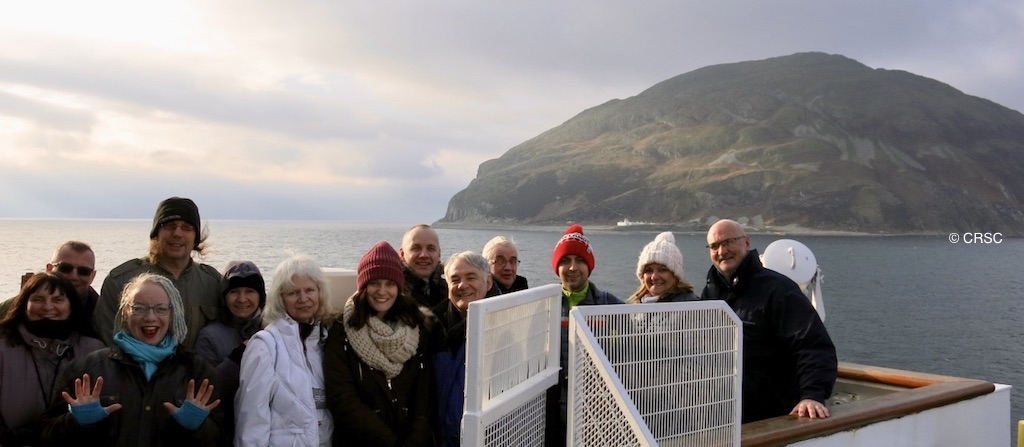
Approaching the Craig: excursionists on the starboard bridge wing included new CRSC members Ian Gall and Suki McGregor (fourth and third from the left). During the cruise nine others paid for a £10 introductory subscription to the Club
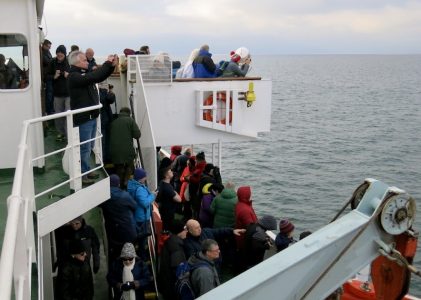
At Ailsa Craig the cameras were out to capture for posterity the impressive sight of the ‘Craig’ in midwinter….

CRSC President Roy Paterson (second from right) and Cruise Coordinator Neil Guthrie (right) with Gordon Law and Rob Beale
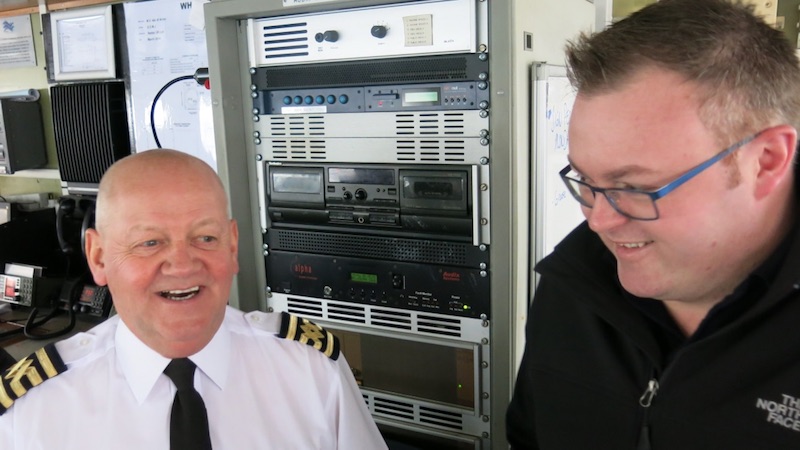
Captain David Allen (left) of Isle of Arran compares notes with off-duty John Simm, who won many admirers as master of Waverley last summer
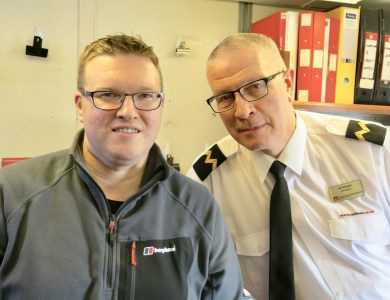
CRSC Cruise Coordinator Neil Guthrie (left) with 2nd Steward Ian Dougan, who was a brilliant intermediary between bridge and ship’s complement

Captain John Simm of Waverley (left) and Jamie Shorthouse, one of the paddler’s engineers, enjoyed the views from Isle of Arran’s port bridge wing
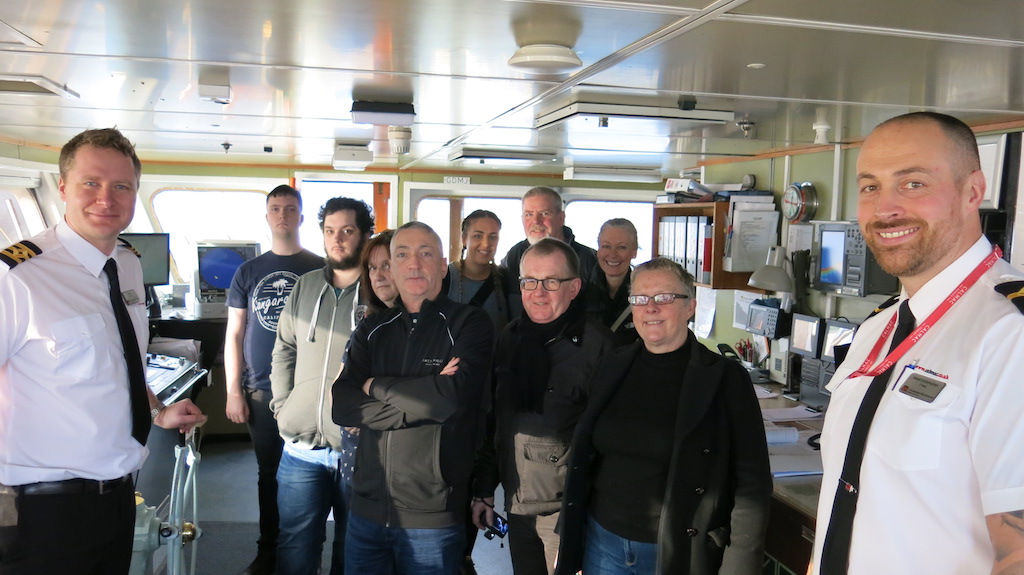
Chief Officer Dennis Hunt (left) and 3rd Mate Robert Fotheringham (right) welcomed successive groups of CRSC excursionists onto the bridge of Isle of Arran. We were shown every courtesy

Captain David Allen and 3rd Mate Robert Fotheringham demonstrate bridge equipment to CRSC excursionists, including Willie Watson, Graeme Hogg and Alice Hickford. Isle of Arran is one of the few remaining ferries to have a traditional steering wheel (out of picture bottom left)

David Edwards (left) and Gavin Stewart (centre) in conversation with PSPS National Chairman Paul Semple

Cammy Shaw (centre) and Cameron Wilson (right), who manned the CRSC stall on board Isle of Arran, were pictured in conversation with Past President Douglas Brown, a pioneer in the development of Club sales in the 1960s and 70s

Lydia Gretton (centre), a Scot who lives in Derby, came north for the Ailsa Craig cruise and became CRSC’s newest member — welcome aboard! She is pictured talking to Cameron Wilson (left). Iain Quinn (right) looks after other visitors to the Club stall, which was kept busy throughout the cruise

First class service: Isle of Arran’s chief cook Dugald MacRail (left) with stewards John Auld, Mairi Beaton, Inna Georgieva, Paul Shaw and Morvern Jackson. The menu included mushroom soup, steak pie and a very tasty burger

Club member James Fisher and his family have become regulars on our New Year excursion – (left to right) James, Aileen, Iain and Iona
Many thanks to everyone who contributed photos, including Robin Copland, Neil Guthrie, Graeme Hogg, Gordon Law, Roy Paterson, Cammy Shaw and Cameron Wilson
Catch up with all CRSC’s news and reports by clicking here.
Published on 21 January 2019













